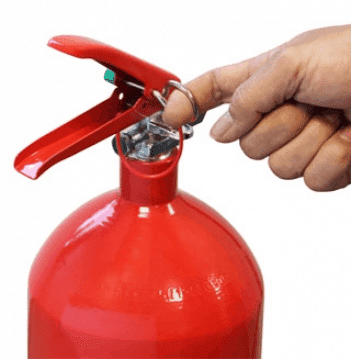CO2 fire extinguishers (Carbon Dioxide) are among the most effective tools for dealing with specific fire types, particularly electrical and flammable liquid fires. In this comprehensive guide, we will explore everything you need to know about CO2 fire extinguishers—how they work, when and where to use them, their benefits and drawbacks, and essential safety tips.

What Is a CO2 Fire Extinguisher?
A CO2 fire extinguisher contains highly pressurized carbon dioxide gas, stored as a liquid. When released, the liquid depressurizes and turns into a gas, which rapidly displaces oxygen in the surrounding air. Fires need oxygen to burn, so by removing it, the extinguisher effectively suffocates the flames.
CO2 fire extinguisher sign is identified by a black label with the words “Carbon Dioxide Fire Extinguisher.” This makes them easy to distinguish from other extinguisher types.
Unlike water or foam extinguishers, CO2 does not cool the fire. Instead, it works purely by removing oxygen, making it ineffective for some fire types such as Class A fires involving solid materials like paper and wood.
How Does CO2 Fire Extinguisher Work?
The carbon dioxide in the extinguisher is stored under high pressure in liquid form. When activated, the liquid rapidly expands into gas, reducing the oxygen concentration in the area and smothering the flames.
Key points:
Displaces oxygen to suffocate the fire.
Leaves no residue, unlike foam or powder extinguishers.
Non-conductive, making it safe for use on electrical equipment.
Because CO2 does not cool the fire, there is a risk of re-ignition if the heat source remains.
Using it correctly is critical to ensure safety and effectiveness:
- Remove the safety pin.
- Aim the hose at the base of the fire, targeting the source of the flames.
- Squeeze the handle to discharge the CO2.
- Sweep the hose side to side, covering the entire fire area.
Safety Tips:
Never use in confined spaces: CO2 displaces oxygen, which can lead to suffocation. Concentrations above 4% can be lethal.
Do not hold the discharge horn unless it is insulated. The horn becomes extremely cold and can cause frostbite. Many modern extinguishers come with a double-skin insulated horn for safer handling.
Read the label and instructions on the extinguisher beforehand so you are prepared in an emergency.
How to Choose and Install a CO2 fire extinguisher?
It typically comes in two standard sizes:
2kg CO2 fire extinguisher: Ideal for smaller fires, often found in offices, retail spaces, and schools.
5kg CO2 fire extinguisher: Suitable for areas with larger electrical installations such as server rooms and mechanical rooms.
Choosing the right size depends on the fire risk in the environment. For areas with a lot of electrical equipment, a larger capacity may offer better coverage and longer discharge time.
It is a requirement in locations with significant electrical fire risks and flammable liquid storage. Common installation areas include:
* Offices
* Server rooms
* Laboratories
* Universities and schools
* Mechanical and electrical rooms
* Casinos
* Fuel storage areas
Installation must comply with local fire safety regulations, and all staff should be trained on proper usage.
Advantages & Disadvantages
Effective on Class B and electrical fires
Safe for electrical equipment due to non-conductive gas
What residue does a co2 fire extinguisher leave when discharged? No residue, protecting electronics and minimizing clean-up
Environmentally friendly, as CO2 is a natural gas and does not damage the ozone layer
Long service life, with many units lasting up to 10 years before needing major maintenance
Risk of asphyxiation in confined or poorly ventilated spaces
Limited cooling effect, increasing the chance of re-ignition
Short discharge range compared to foam or water extinguishers
Not refillable on-site, requiring specialized service for refilling
Cold discharge can cause frostbite if the horn is handled during use
Not effective on fires involving solid materials like wood or textiles
Types of Fires CO2 Extinguishers Can and Cannot Tackle
Suitable For:
Electrical fires: Ideal for computers, server rooms, and electrical appliances.
Class B fires: Fires involving flammable liquids such as petrol, diesel, paraffin, and paint.
Not Suitable For:
Class A fires: Involving wood, paper, textiles, and similar solid combustibles.
Class F fires: Including cooking oils and fats like chip pans and deep fryers.
Fires in confined spaces: CO2 can quickly replace oxygen and cause suffocation.
It is worth noting that CO2 is the only type of extinguisher suitable for live electrical fires. Using water-based or foam extinguishers in such scenarios could be dangerous.
How to Identify a CO2 Fire Extinguisher
You can identify a CO2 extinguisher by the black label with white writing indicating “Carbon Dioxide Fire Extinguisher.” This label helps users quickly distinguish CO2 units from water (red label), foam (cream label), or dry powder (blue label) extinguishers.
CO2 fire extinguishers are a vital component of any fire safety plan, especially in environments where electrical equipment or flammable liquids are present. They are highly effective, leave no residue, and are safe for sensitive electronics. However, they must be used with caution, especially in confined spaces, due to the risk of suffocation.
Understanding when and how to use a CO2 fire extinguisher can make a critical difference in safely managing a fire emergency. Ensure your workplace or facility is equipped with the appropriate type and size of extinguishers and that all personnel are properly trained in their use.
